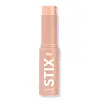What's inside
What's inside
 Key Ingredients
Key Ingredients

 Benefits
Benefits

 Concerns
Concerns

 Ingredients Side-by-side
Ingredients Side-by-side

Pentaerythrityl Tetraisostearate
EmollientPhenyl Trimethicone
Skin ConditioningCaprylyl Methicone
Skin ConditioningParaffin
PerfumingCaprylic/Capric Triglyceride
MaskingCeresin
Emulsion StabilisingCopernicia Cerifera Wax
Cetyl PEG/PPG-10/1 Dimethicone
EmulsifyingHydrogenated Soybean Oil
EmollientAlumina
AbrasiveLauryl Laurate
Skin ConditioningSynthetic Fluorphlogopite
Vp/Hexadecene Copolymer
Stearic Acid
CleansingHydrated Silica
AbrasiveSynthetic Beeswax
Emulsion StabilisingCalcium Sodium Borosilicate
Calcium Aluminum Borosilicate
Aluminum Calcium Sodium Silicate
Silica
AbrasiveTin Oxide
AbrasiveTriethoxycaprylylsilane
Phenoxyethanol
PreservativeCaprylyl Glycol
EmollientDiethylhexyl Syringylidenemalonate
Skin ProtectingMicrocrystalline Wax
Emulsion StabilisingTocopherol
AntioxidantPotassium Sorbate
PreservativeWater
Skin ConditioningHexylene Glycol
EmulsifyingIron Oxides
Mica
Cosmetic ColorantTitanium Dioxide
Cosmetic ColorantCI 77891
Cosmetic ColorantPentaerythrityl Tetraisostearate, Phenyl Trimethicone, Caprylyl Methicone, Paraffin, Caprylic/Capric Triglyceride, Ceresin, Copernicia Cerifera Wax, Cetyl PEG/PPG-10/1 Dimethicone, Hydrogenated Soybean Oil, Alumina, Lauryl Laurate, Synthetic Fluorphlogopite, Vp/Hexadecene Copolymer, Stearic Acid, Hydrated Silica, Synthetic Beeswax, Calcium Sodium Borosilicate, Calcium Aluminum Borosilicate, Aluminum Calcium Sodium Silicate, Silica, Tin Oxide, Triethoxycaprylylsilane, Phenoxyethanol, Caprylyl Glycol, Diethylhexyl Syringylidenemalonate, Microcrystalline Wax, Tocopherol, Potassium Sorbate, Water, Hexylene Glycol, Iron Oxides, Mica, Titanium Dioxide, CI 77891
Octyldodecanol
EmollientPentaerythrityl Tetraethylhexanoate
EmollientSynthetic Beeswax
Emulsion StabilisingSilica
AbrasiveTrioctyldodecyl Citrate
EmollientButyrospermum Parkii Butter
Skin ConditioningJojoba Esters
EmollientMicrocrystalline Wax
Emulsion StabilisingPolyethylene
AbrasiveDipentaerythrityl Hexahydroxystearate/Hexastearate/Hexarosinate
Skin ConditioningPhenyl Trimethicone
Skin ConditioningTocopheryl Acetate
AntioxidantAscorbyl Palmitate
AntioxidantLecithin
EmollientPvp
Emulsion StabilisingCaprylyl Glycol
EmollientPentaerythrityl Tetra-Di-T-Butyl Hydroxyhydrocinnamate
AntioxidantMica
Cosmetic ColorantCI 77891
Cosmetic ColorantCI 77491
Cosmetic ColorantCI 77492
Cosmetic ColorantCI 77499
Cosmetic ColorantCI 77000
Cosmetic ColorantCI 77163
Cosmetic ColorantCI 42090
Cosmetic ColorantCI 77400
Cosmetic ColorantCI 75470
Cosmetic ColorantCI 77289
Cosmetic ColorantCI 77288
Cosmetic ColorantCI 77510
Cosmetic ColorantCI 15850
Cosmetic ColorantCI 45410
Cosmetic ColorantCI 73360
Cosmetic ColorantCI 17200
Cosmetic ColorantCI 77007
Cosmetic ColorantCI 19140
Cosmetic ColorantOctyldodecanol, Pentaerythrityl Tetraethylhexanoate, Synthetic Beeswax, Silica, Trioctyldodecyl Citrate, Butyrospermum Parkii Butter, Jojoba Esters, Microcrystalline Wax, Polyethylene, Dipentaerythrityl Hexahydroxystearate/Hexastearate/Hexarosinate, Phenyl Trimethicone, Tocopheryl Acetate, Ascorbyl Palmitate, Lecithin, Pvp, Caprylyl Glycol, Pentaerythrityl Tetra-Di-T-Butyl Hydroxyhydrocinnamate, Mica, CI 77891, CI 77491, CI 77492, CI 77499, CI 77000, CI 77163, CI 42090, CI 77400, CI 75470, CI 77289, CI 77288, CI 77510, CI 15850, CI 45410, CI 73360, CI 17200, CI 77007, CI 19140
Ingredients Explained
These ingredients are found in both products.
Ingredients higher up in an ingredient list are typically present in a larger amount.
Caprylyl Glycol is a humectant and emollient, meaning it attracts and preserves moisture.
It is a common ingredient in many products, especially those designed to hydrate skin. The primary benefits are retaining moisture, skin softening, and promoting a healthy skin barrier.
Though Caprylyl Glycol is an alcohol derived from fatty acids, it is not the kind that can dry out skin.
This ingredient is also used as a preservative to extend the life of products. It has slight antimicrobial properties.
Learn more about Caprylyl GlycolCi 77891 is a white pigment from Titanium dioxide. It is naturally found in minerals such as rutile and ilmenite.
It's main function is to add a white color to cosmetics. It can also be mixed with other colors to create different shades.
Ci 77891 is commonly found in sunscreens due to its ability to block UV rays.
Learn more about CI 77891Mica is a naturally occurring mineral used to add shimmer and color in cosmetics. It can also help improve the texture of a product or give it an opaque, white/silver color.
Serecite is the name for very fine but ragged grains of mica.
This ingredient is often coated with metal oxides like titanium dioxide. Trace amounts of heavy metals may be found in mica, but these metals are not harmful in our personal products.
Mica has been used since prehistoric times throughout the world. Ancient Egyptian, Indian, Greek, Roman, Aztec, and Chinese civilizations have used mica.
Learn more about MicaMicrocrystalline Wax is created by de-oiling petroleum. It is highly refined and purified before being added to cosmetics.
Microcrystalline Wax is used to enhance the texture and create even consistency. It helps stabilize a product by preventing ingredients from separating.
Phenyl Trimethicone is a silicon-based polymer. It is derived from silica.
Phenyl Trimethicone is used as an emollient and prevents products from foaming.
As an emollient, it helps trap moisture in the skin. It is considered an occlusive.
Learn more about Phenyl TrimethiconeSilica, also known as silicon dioxide, is a naturally occurring mineral. It is used as a fine, spherical, and porous powder in cosmetics.
Though it has exfoliant properties, the function of silica varies depending on the product.
The unique structure of silica enhances the spreadability and adds smoothness, making it a great texture enhancer.
It is also used as an active carrier, emulsifier, and mattifier due to its ability to absorb excess oil.
In some products, tiny microneedles called spicules are made from silica or hydrolyzed sponge. When you rub them in, they lightly polish away dead skin layers and enhance the penetration of active ingredients.
Learn more about SilicaSynthetic beeswax is created to be identical in structure to beeswax. It possesses the same occlusive and emulsion properties.
A blend of fatty acid esters, fatty acids, and alcohols are used to create synthetic beeswax. Whether or not this ingredient is vegan depends on the source. Sometimes, lanolin is used for its creation.
This ingredient may not be Malassezia folliculitis, or fungal-acne safe.
Learn more about Synthetic Beeswax